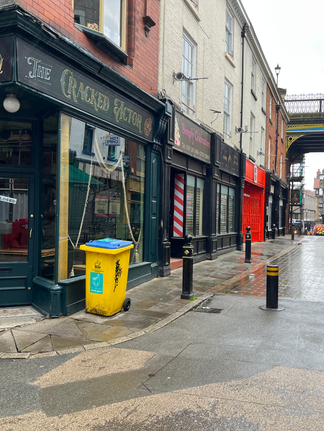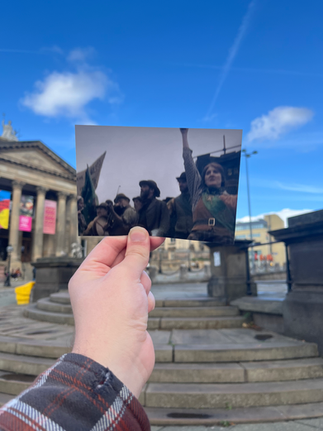Scene to Stout: Visiting the world of House of Guinness
- joshanthonyharris
- Sep 25
- 5 min read
With House of Guinness, creator Steven Knight (of Peaky Blinders fame) brings viewers into the turbulent world of the late 19th-century Guinness dynasty, beginning in 1868 after the sudden death of Benjamin Guinness. Although the narrative is rooted in Dublin and New York, much of the series was shot across Northern England—making modern cities like Liverpool, Manchester, and Stockport once again stand in for historic settings.
Liverpool stands out among the filming locations, its grand civic architecture and docklands doubling as parts of Dublin and the Guinness brewery’s surroundings. From St. George’s Hall and William Brown Street to Stanley Dock and Croxteth Hall, many of the city’s iconic backdrops have been transformed into evocative period sets.
But the magic doesn’t stop in Merseyside. In Manchester, the Northern Quarter and streets like Dale Street have been redressed into bustling 19th-century thoroughfares, while studios provided controlled indoor environments. Meanwhile, in neighbouring Stockport, historic streets such as the Underbank's and landmarks like St Mary’s Church invite fans and visitors alike to step into the show’s universe.
Stockport

The first spot on my trip was the historic market town of Stockport, located just 8 miles South East of Manchester. Stockport plays a surprisingly starring role in the series, especially the Underbank area — a historic quarter of the town centre with cobbled streets and richly detailed architecture. With careful set dressing and props, the streets were transformed to resemble the 19th century Dublin. You can see these streets a few times in the series, but most notably at the start of Episode 1 when Patrick Cochrane starts the Irish rebellion against the Guinness funeral parade. Along these streets you will also find The Cracked Actor bar which was reimagined as 'The Oak' another location which helps ground the show.

Also in Stockport, you will find St Mary's church in Churchgate, where an opulent tombstone bearing the name 'Benjamin Lee Guinness' was added. Whilst not seen in the trailer, there was behind the scenes photos taken whilst they were filming at the church. The clever way the production team have used these areas rich in history, and added details to develop the story was impressive and adds for an amazing immersive experience in Stockport.
Manchester

After a 10/15 minute train ride from Stockport into Manchester Piccadilly, it was easy enough to stumble across the next filming location. Manchester's Northern Quarter is the city's most character filled neighbourhood with a patchwork of red brick warehouses, narrow alleys, independent shops and rich industrial elegance. For the series the streets of Back Piccadilly, Lever Street, Tariff Street & Dale Street were dressed with market stalls, horse drawn carts, dirt covered floors and period appropriate shop fronts. By closing the streets and painstakingly building this world on period architecture has created a gorgeous background of 19th century Dublin that will keep an audience immersed.

You will also see Manchester in a few scenes where they used the old university Sackville Street building as the Imperial Hotel Dublin. With its wooden detailing, black and white floor and grand doors, it was a perfect choice to add into the story. Sadly the building is no longer publicly accessible, but you can see what it looks like thanks to photos taken by people before it was closed for construction. (https://www.manchestersfinest.com/articles/building-secrets-sackville-street-building/)
Liverpool
The final stop on my trip was the grand city of Liverpool. Whilst Liverpool has been used for blockbuster pictures and groundbreaking TV series, the city was used as a main part of bringing the story to life. With St George's Hall and William Brown street standing in for 19th century Dublin, as a backdrop in episode 1 when the Irish rebellions crash the Guinness funeral march and ends in a fight. The back passage of St Georges Hall also appears in a dark secretive meeting between Sean Rafferty and Anne Guinness in episode 1.

Staying in the city centre, I moved across to the town hall where you find the grand structure of Exchange Flags with its impressive windows, stark white brick work and overall grand feeling. This featured towards the start of episode 2 where the Guinness family leave the will reading in various states of shock and anger.
The grand Stanley Docks was used heavily throughout the series as the Guinness brewery exterior. The impressive structure was perfect for capturing the scale and industrial feel necessary for scenes around the brewing empire. This site wasn't the first time creator Steven Knight visited as you may remember it from the early seasons of Peaky Blinders as the streets of Birmingham where the Garrison pub was located. Whilst the is location undergoing construction work to become apartments, you can clearly see the street used by standing outside the office space just off Regent Road.

The Georgian quarter of the city got transformed into 1860's Dublin with streets including Mount and Pilgrim streets seeing period dressed actors, horse drawn carriages and temporary signs to help transform these locations into backdrops for the series. Whilst these streets weren't seen in the trailer, you can again see how they used the streets using behind the scenes photos.
There were two filming locations in the Liverpool area that I didn't manage to visit on my trip, but I wanted to share for people wanting to visit. The first one is the grand Croxteth Hall, this Grade II country estate with a grand mansion stood in for various locations in the series, including the Guinness family home staircase as well as the courtyard being some backstreets in episode 2. The estate hall is open on various dates through the next months so you can immerse yourself in the world of Guinness. (https://liverpoolcityhalls.co.uk/events/event/guided-tours-at-croxteth-hall/). The second location is Sefton Park Palm House, a grand Victorian structure full of lush flora. This was used for a scene in episode 2 where Arthur is seen having a private meeting with a man around one of the lily ponds.
Exploring the filming locations of House of Guinness across Stockport, Manchester and Liverpool has been an incredible journey with each stop offering a chance to step back into the 19th century and see how everyday streets, historic landmarks, and hidden corners were transformed into the world of the Guinness dynasty. What struck me most was the care and detail that went into recreating Dublin and New York in these Northern cities, from the cobbled streets of Stockport’s Underbank to the grand civic spaces of Liverpool. Visiting in person gives you a real sense of the scale of production, and it’s fascinating to compare the on-screen drama with the real-world locations that brought it to life.
For anyone inspired to follow in these footsteps, the good news is that many of these sites are easy to visit—Stockport’s Underbanks and St Mary’s Church are open to the public, Manchester’s Northern Quarter is a vibrant hub of shops and cafés, and Liverpool’s landmarks like St George’s Hall and the Georgian Quarter are city highlights in their own right. House of Guinness is streaming now on Netflix, making it the perfect time to watch with an eye for those details you can later spot in person. I can’t wait to see how the story unfolds in the final episodes, and I’ll be updating this blog with fresh locations once I’ve watched them.











































Comments